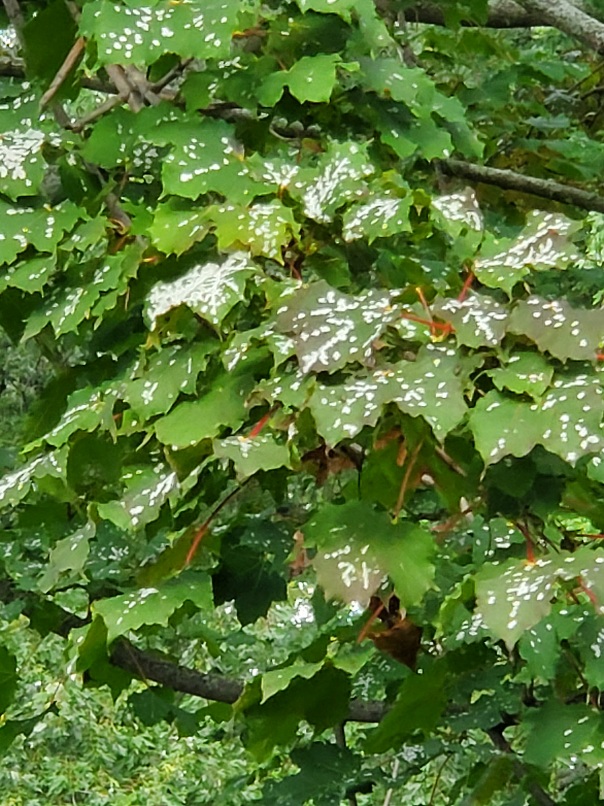
Hello, We have a huge maple ( Norway?) which shades a rock garden on a hill in the backyard. We live in Scarborough southwest 1.4 kms from the lake. This year most of the leaves have a raised bump as seen in the picture. A green moss ? also is seen on the bark which faces south Also the Solomon’s Seal plant beneath it had 2 different issues this year, one was sawfly, I believe, as evidenced in the picture.The other was a powdery substance where the stem meets the leaf. Sorry no picture for that. I am concerned about the whole environment and what I should be doing for fall clean up. Also in the garden are 3 vines, Virginia creeper, periwinkle and Boston ivy. I am trying to get rid of the Virginia creeper and the periwinkle ( in one part of garden) so any tips would be greatly appreciated. I believe the Norway and periwinkle are invasive here. I can’t do much about the tree as it’s full grown. Thank you. I can only upload 1 picture. So the Solomon’s Seal leaves have been eaten in strips from the stem to the outer edge of the leaf. Several of these occur in a pattern all the way along each leaf. I used soap and water to stop the advancement but most of the crop is effected.
Hello,
From your photo it appears that your Norway maple has powdery mildew. There are a variety of powdery mildew fungus each of which are host specific. Powdery mildew also affects Norway maples year after year, however it seems that this year it is more prevalent. Powdery mildew is usually found when the humidity is above 90%.
Although unsightly, powdery mildew is relatively benign to the health and vigor of your tree since most infections occur late during the growing season. Therefore, treatment is often unnecessary. However, there are several cultural practices that you can implement to help minimize future infection: (1) maximize airflow and direct sunlight to your tree. Norway maples have a dense canopy with limited airflow which is why they are prone to this disease. Lightly pruning some of your tree’s canopy to allow a bit more sun and airflow to get to the remaining leaves will help. It is advisable to have an ISA certified arborist come in to do the job properly. To find a certified professional arborist to help you with a tree problem, visit the International Society of Arboriculture’s searchable database here.
(2) Minimize humid conditions around your tree. This can be avoided by avoiding to water with a sprinkler when it is hot outside. Instead use a soaker hose or try slow drip watering with a hose at the base of your plants. Clear away some of the dense undergrowth around your tree.
(3) Rake and dispose of fallen leaves during autumn to remove the fungal spores. Cleaning up affected leaves around the base of the tree is a good practice. Dispose of these leaves, and never put them in your compost.
(4) Follow proper tree maintenance to increase the vigor of your tree by proper watering, fertilizing, and pruning. A healthy tree is less susceptible to disease.
Clearing away the English ivy and periwinkle around your tree by digging out as much of the roots as possible will also help with the powdery mildew by increasing the airflow around your tree. This will also help with what is affecting your Solomon’s seal. It is difficult to see from your photo however I suspect that your plant has been consumed by slugs which live and thrive in dark moist environments. We have handled this issue in several queries on our website. Simply type slugs into the Find it Here box located on the right side of our home page to find a number of our archived posts.
Again, without a clear photo it is difficult to tell what the “green moss” is on your tree trunk, however I suspect that it is lichen. If the growth is lichen, we have attached an article below for your reference, and there is no cause for alarm.

